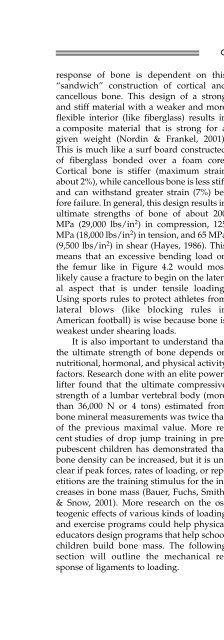Fundamentals of Biomechanics
Fundamentals of Biomechanics
Fundamentals of Biomechanics
You also want an ePaper? Increase the reach of your titles
YUMPU automatically turns print PDFs into web optimized ePapers that Google loves.
esponse <strong>of</strong> bone is dependent on this<br />
“sandwich” construction <strong>of</strong> cortical and<br />
cancellous bone. This design <strong>of</strong> a strong<br />
and stiff material with a weaker and more<br />
flexible interior (like fiberglass) results in<br />
a composite material that is strong for a<br />
given weight (Nordin & Frankel, 2001).<br />
This is much like a surf board constructed<br />
<strong>of</strong> fiberglass bonded over a foam core.<br />
Cortical bone is stiffer (maximum strain<br />
about 2%), while cancellous bone is less stiff<br />
and can withstand greater strain (7%) before<br />
failure. In general, this design results in<br />
ultimate strengths <strong>of</strong> bone <strong>of</strong> about 200<br />
MPa (29,000 lbs/in 2 ) in compression, 125<br />
MPa (18,000 lbs/in 2 ) in tension, and 65 MPa<br />
(9,500 lbs/in 2 ) in shear (Hayes, 1986). This<br />
means that an excessive bending load on<br />
the femur like in Figure 4.2 would most<br />
likely cause a fracture to begin on the lateral<br />
aspect that is under tensile loading.<br />
Using sports rules to protect athletes from<br />
lateral blows (like blocking rules in<br />
American football) is wise because bone is<br />
weakest under shearing loads.<br />
It is also important to understand that<br />
the ultimate strength <strong>of</strong> bone depends on<br />
nutritional, hormonal, and physical activity<br />
factors. Research done with an elite powerlifter<br />
found that the ultimate compressive<br />
strength <strong>of</strong> a lumbar vertebral body (more<br />
than 36,000 N or 4 tons) estimated from<br />
bone mineral measurements was twice that<br />
<strong>of</strong> the previous maximal value. More recent<br />
studies <strong>of</strong> drop jump training in prepubescent<br />
children has demonstrated that<br />
bone density can be increased, but it is unclear<br />
if peak forces, rates <strong>of</strong> loading, or repetitions<br />
are the training stimulus for the increases<br />
in bone mass (Bauer, Fuchs, Smith,<br />
& Snow, 2001). More research on the osteogenic<br />
effects <strong>of</strong> various kinds <strong>of</strong> loading<br />
and exercise programs could help physical<br />
educators design programs that help school<br />
children build bone mass. The following<br />
section will outline the mechanical response<br />
<strong>of</strong> ligaments to loading.<br />
CHAPTER 4: MECHANICS OF THE MUSCULOSKELETAL SYSTEM 77<br />
BIOMECHANICS OF<br />
LIGAMENTS<br />
Ligaments are tough connective tissues that<br />
connect bones to guide and limit joint motion,<br />
as well as provide important proprioceptive<br />
and kinesthetic afferent signals<br />
(Solomonow, 2004). Most joints are not perfect<br />
hinges with a constant axis <strong>of</strong> rotation,<br />
so they tend to have small accessory motions<br />
and moving axes <strong>of</strong> rotation that<br />
stress ligaments in several directions. The<br />
collagen fibers within ligaments are not<br />
arranged in parallel like tendons, but in a<br />
variety <strong>of</strong> directions. Normal physiological<br />
loading <strong>of</strong> most ligaments is 2–5% <strong>of</strong> tensile<br />
strain, which corresponds to a load <strong>of</strong> 500<br />
N (112 lbs) in the human anterior cruciate<br />
ligament (Carlstedt & Nordin, 1989), except<br />
for “spring” ligaments that have a large<br />
percentage <strong>of</strong> elastin fibers (ligamentum<br />
flavum in the spine), which can stretch<br />
more than 50% <strong>of</strong> their resting length. The<br />
maximum strain <strong>of</strong> most ligaments and tendons<br />
is about 8–10% (Rigby, Hirai, Spikes,<br />
& Eyring, 1959).<br />
Like bone, ligaments and tendons remodel<br />
according to the stresses they are<br />
subjected to. A long-term increase in the<br />
mechanical strength <strong>of</strong> articular cartilage<br />
with the loads <strong>of</strong> regular physical activity<br />
has also been observed (Arokoski, Jurvelin,<br />
Vaatainen, & Helminen, 2000). Inactivity,<br />
however, results in major decreases in the<br />
mechanical strength <strong>of</strong> ligaments and tendon,<br />
with reconditioning to regain this<br />
strength taking longer than deconditioning<br />
(Carlstedt & Nordin, 1989). The ability <strong>of</strong><br />
the musculoskeletal system to adapt tissue<br />
mechanical properties to the loads <strong>of</strong> physical<br />
activity does not guarantee a low risk <strong>of</strong><br />
injury. There is likely a higher risk <strong>of</strong> tissue<br />
overload when deconditioned individuals<br />
participate in vigorous activity or when<br />
trained individuals push the envelope,<br />
training beyond the tissue's ability to adapt<br />
during the rest periods between training






